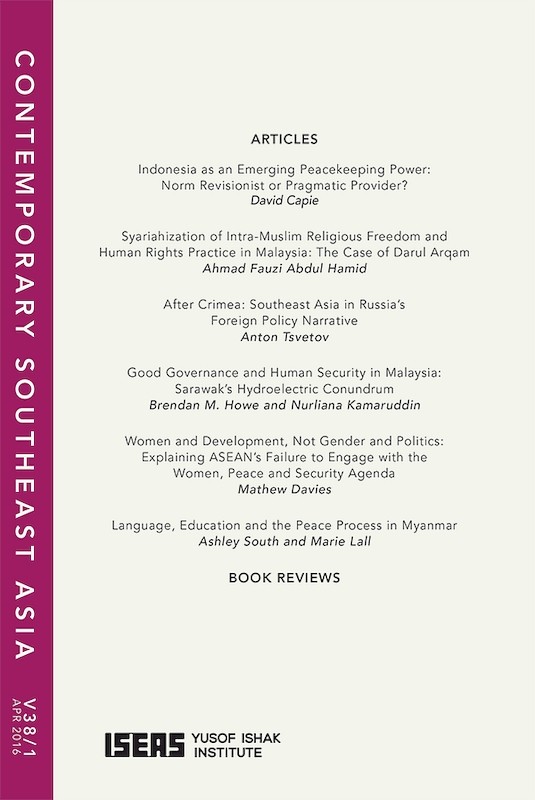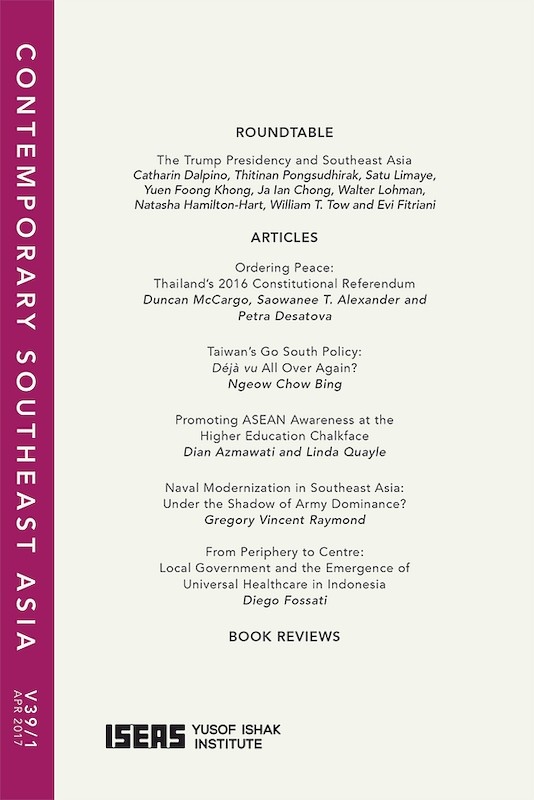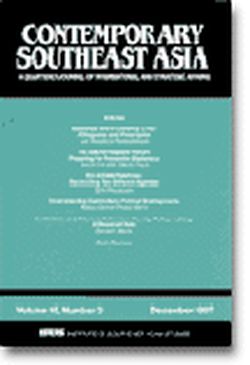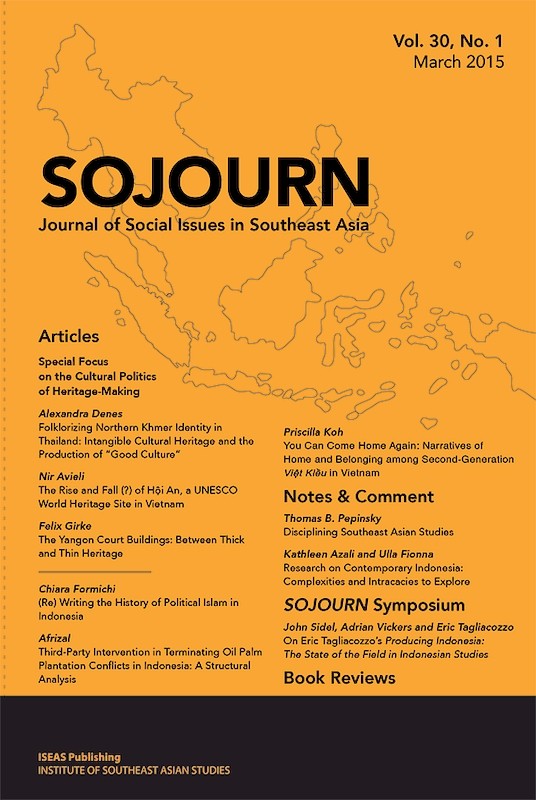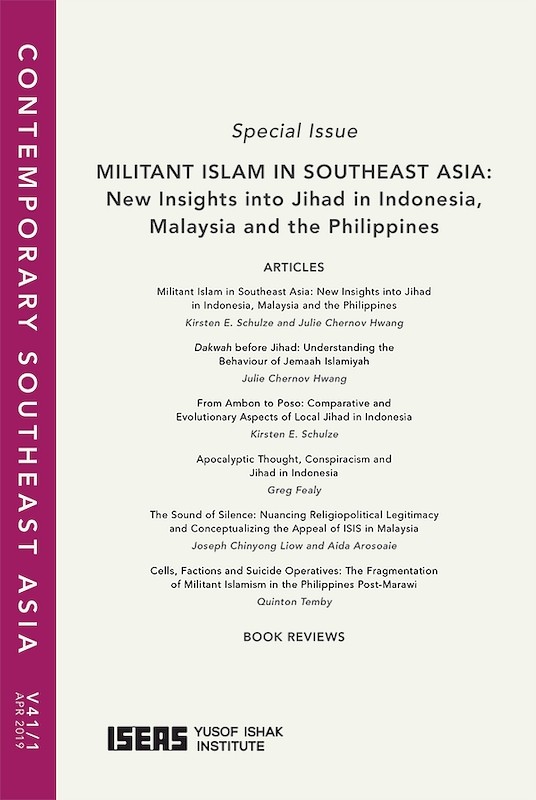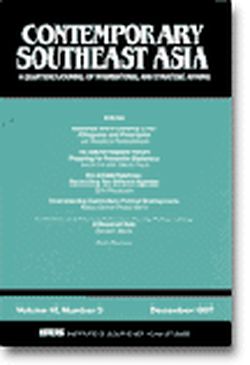Contemporary Southeast Asia Vol. 40/3 (December 2018)
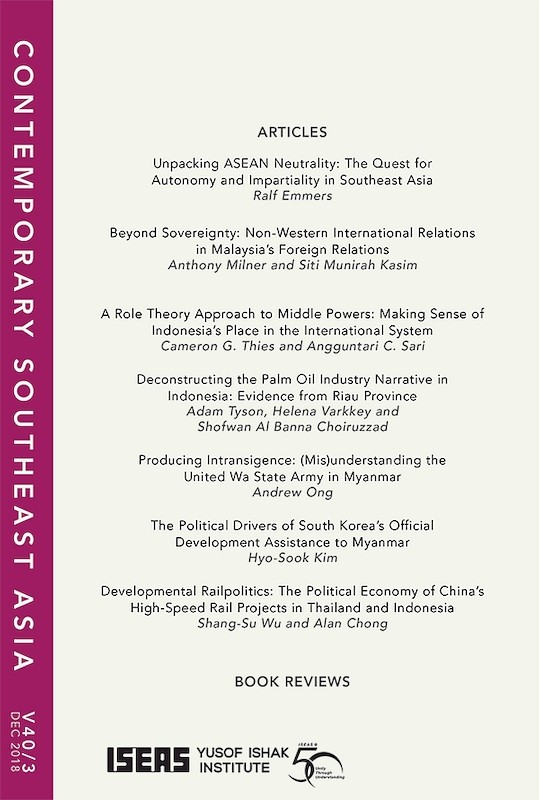
Ian Storey, editor
Date of publication:
December 2018
Publisher:
ISEAS – Yusof Ishak Institute
Number of pages:
200
Code:
CS40/3
About the publication
- Attained impact factor of 0.906 in Social Sciences Citation Index 2017
- Ranked 18th by Google Scholar Metrics 2018 in the Asian Studies and History category
Contents
-
Contemporary Southeast Asia Vol. 40/3 (December 2018)
[Whole Publication, ISSN: 1793284X] -
Preliminary pages
- ARTICLES
-
1. Unpacking ASEAN Neutrality: The Quest for Autonomy and Impartiality in Southeast Asia, by Ralf Emmers, author see abstractThe Association of Southeast Asian Nations (ASEAN) has preferred to avoid entanglement in Great Power competition since its inception in 1967. The 1971 Zone of Peace, Freedom and Neutrality (ZOPFAN) Declaration captured ASEAN’s aspiration to keep Southeast Asia neutral and free of external interference. ZOPFAN accommodated divergent strategic outlooks within ASEAN while avoiding the legalities associated with the concept of neutrality. While no consensus was ever reached on ZOPFAN’s specific application, neutrality is continually mentioned as a critical factor in ASEAN’s success. The article argues that ASEAN neutrality is defined by impartiality and autonomy, and that this concept has evolved over time as its specific meaning has changed due to shifting geopolitical circumstances. At the organization’s inception, and during the bipolarity of the Cold War, ASEAN’s focus was on autonomy. However, since the early 2000s, the emphasis has evolved to impartiality due to increasing multipolarity in the Asia-Pacific region. The concept of neutrality has been tested in recent years with the intensification of the South China Sea dispute.
-
2. Beyond Sovereignty: Non-Western International Relations in Malaysia’s Foreign Relations, by Anthony Milner, Siti Munirah Kasim, authors see abstractAs with other countries, Malaysia expresses concern about national sovereignty and issues related to the distribution and balance of power. But Malaysia’s foreign policy behaviour has some distinctive features, and these may be explained partly in terms of the heritage of pre-modern thinking. That heritage of non-Western International Relations (IR) — which includes perspectives on the character of the state, the interests of the state and international order (moral as well as political) — differs radically from post-Westphalian thinking. This article seeks to promote a dialogue between IR and Area Studies. It employs a textual analysis approach from the history of ideas in order to uncover concepts and perspectives which informed inter-polity behaviour in the pre-modern Malay world. It examines the consequences of the absence of national sovereignty as a key articulating concept, and also identifies a number of alternative local concepts that shaped Malay thinking about foreign relations, in particular the ideas of <i>kerajaan</i> (the ruler-centred polity) and <i>nama</i> (reputation, status). The article makes preliminary observations about the way pre-modern Malay ideas might be an influence on Malaysia’s foreign relations today — for instance, in its China policy and particular approach towards ASEAN regionalism. It is argued that such ideas at the very least have provided reference points in the process of developing Malaysia’s foreign policy. Detailed investigation of the Malay heritage, it is argued, is also valuable in advancing the study of non-Western IR.
-
3. A Role Theory Approach to Middle Powers: Making Sense of Indonesia’s Place in the International System, by Cameron G. Thies, Angguntari C. Sari, authors see abstractThis article provides a conceptual framework for understanding middle powers based on foreign policy role theory. It argues that role theory helps to reconcile existing approaches rooted in functional, behavioural, hierarchical and rhetorical definitions. Role theory has been usefully applied to the study of other statuses, such as major and emerging powers in the international system. This article defines a middle power as a type of status that is supported by auxiliary roles recognized by significant others. Roles which middle powers are expected to perform also provide a relational, social identity approach to classifying middle powers as opposed to one that is purely rhetorical or focused on self-conception of status. This article applies this roles-based framework to the case of Indonesia and finds that Southeast Asia’s largest country qualifies as a middle power, suggesting it may be usefully applied to classify other middle powers.
-
4. Deconstructing the Palm Oil Industry Narrative in Indonesia: Evidence from Riau Province, by Adam Tyson, Helena Varkkey, Shofwan Al Banna Choiruzzad, authors see abstractIndonesia is the leading global producer of crude palm oil. Mass production of palm oil requires large-scale land conversion, resulting in Indonesia having the world’s highest rate of annual primary forest loss. Given the contentious nature and scale of palm oil production, this article considers Indonesia as a variant of the developmental patrimonialism model often applied to African countries. Developmental patrimonialism in the Indonesian context suggests that state power — expressed through various discourse and policy coalitions — favours palm oil companies and seeks legitimation through claims about national economic benefits. This development model may lead to absolute poverty reduction, employment and tax revenue, but can also produce inequality, resource dependencies and environmental degradation. From the authors’ observations in Riau province, there is a mismatch between the national narrative of palm oil as a force for good and the conspicuous underinvestment in public services and infrastructure, which undermines the legitimacy of some palm oil industry claims. The complexity of village Riau casts further doubt on generalized claims about rural development. Local variance in Riau’s palm oil belt is attributed to, among other things, the complex nature of political patronage, uneven access to land, volatile pricing trends, problematic financing and loan schemes, and the role played by village cooperatives.
-
5. Producing Intransigence: (Mis)understanding the United Wa State Army in Myanmar, by Andrew Ong, author see abstractThis article examines the casting of the United Wa State Army (UWSA) as an intransigent and dangerous actor in the Myanmar peace process. It analyses how media narratives express two simultaneous yet contrastive qualities of the Wa Region and the UWSA: rigidity and fluidity. Fluidity in access to illegible shadow networks is perceived as untrustworthiness and threat, while the rigidity of their military might and disengagement from the peace process is read as an uncompromising and hostile stance. These narratives frame interpretations of UWSA political practice, ultimately accentuating rigidity and downplaying fluidity, producing a widely-accepted misconception of UWSA intransigence that forecloses possibilities for compromise. Yet the UWSA is hardly reclusive and isolated, nor stubbornly opposed to engagement. Engaging the UWSA requires an understanding of the organization’s political culture, especially its self-image of autonomy and self-reliance. A careful contextualization of its actions suggests that seeking ways to integrate it into the Union of Myanmar should be a central form of engagement, in which the international community should play a more significant role.
-
6. The Political Drivers of South Korea’s Official Development Assistance to Myanmar, by Kim Hyo-Sook, author see abstractSince the early 2010s, South Korea has increased its official development assistance (ODA) to Myanmar. Previous studies have highlighted the economic benefits of ODA to both South Korea and Myanmar, but the political motivations of Seoul’s ODA policy towards Naypyidaw have received less scholarly attention. To fill this literature gap, this article analyses the three political factors underlying South Korea’s increased ODA to Myanmar over the past ten years: Seoul’s considerations regarding North Korea; South Korea’s geopolitical competition with China and Japan; and the domestic constituents of ODA policymaking in South Korea. Adopting the concepts of realism and soft power, this article argues that national security interests and political motivations, including the intentions of ODA policymakers led by the president, have been important drivers of South Korea’s increased ODA to Myanmar. In examining the role of domestic policymaking dynamics, this article uses as a case-study the K-town project in Myanmar which figured in the 2016 Choi Soon-sil-Gate scandal.
-
7. Developmental Railpolitics: The Political Economy of China’s High-Speed Rail Projects in Thailand and Indonesia, by Wu Shang-Su, Alan Chong, authors see abstractDevelopmental railpolitics advances Chinese geostrategic ambitions without the overt opprobrium commonly generated by such issues as China’s militarization of the South China Sea, military modernization, border conflicts and trade disputes. This article examines the implications of planned Chinese high-speed rail (HSR) investments in Thailand and Indonesia. The HSR project in Thailand represents an important advance in China’s geopolitical influence through the larger design of the Singapore–Kunming Rail Link (SKRL), while the one in Indonesia is aimed at forging better economic ties with the largest country in Southeast Asia. It also assesses the room for political manoeuvre by those two countries vis-à-vis China’s developmental railpolitics. Thailand considers the Chinese HSR project as only its first step to achieve its ambitious goal of becoming a land transportation hub in Indochina. Moreover, the Kingdom is still practising a strategy of balancing foreign powers. The HSR project in Indonesia also reflects changing political considerations on contracting foreign partners to build infrastructure. The conclusions suggest that China can be outmanoeuvred in railway bargaining by the recipient states, depending on geopolitical positioning and the nature of their domestic political and economic conditions.
- BOOK REVIEWS
-
BOOK REVIEW: The New ASEAN in Asia Pacific & Beyond. By Shaun Narine., by Linda Quayle, author
-
BOOK REVIEW: Strangers Next Door? Indonesia and Australia in the Asian Century. Edited by Tim Lindsey and Dave McRae., by Evan A. Laksmana, author
-
BOOK REVIEW: Rock Solid: How the Philippines Won Its Maritime Case against China. By Marites Dañguilan Vitug, by Malcolm Cook, author
-
BOOK REVIEW: Anatomy of an Electoral Tsunami. By Lim Teck Ghee, S. Thayaparan and Terence Netto, by Carl Vadivella Belle, author
-
BOOK REVIEW: Dividing ASEAN and Conquering the South China Sea: China’s Financial Power Projection. By Daniel C. O’Neill, by Gregory B. Poling, author
-
BOOK REVIEW: The Four Flashpoints: How Asia Goes to War. By Brendan Taylor., by Sam Bateman, author
-
BOOK REVIEW: Becoming Better Muslims: Religious Authority and Ethical Improvement in Aceh, Indonesia. By David Kloos; Chinese Ways of Being Muslim: Negotiating Ethnicity and Religiosity in Indonesia. By Hew Wai Weng., by Charlotte Setijadi, author

